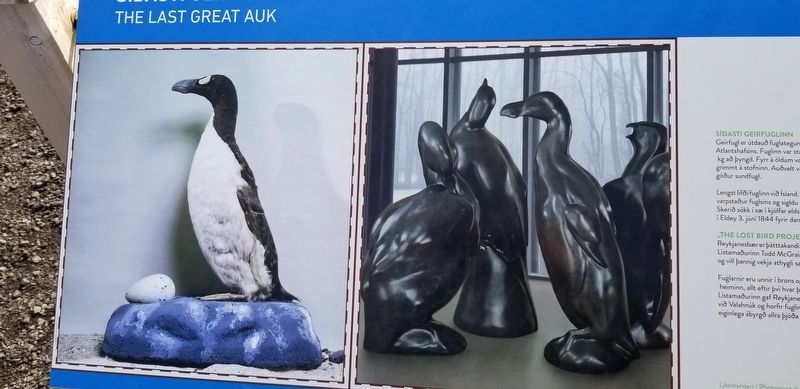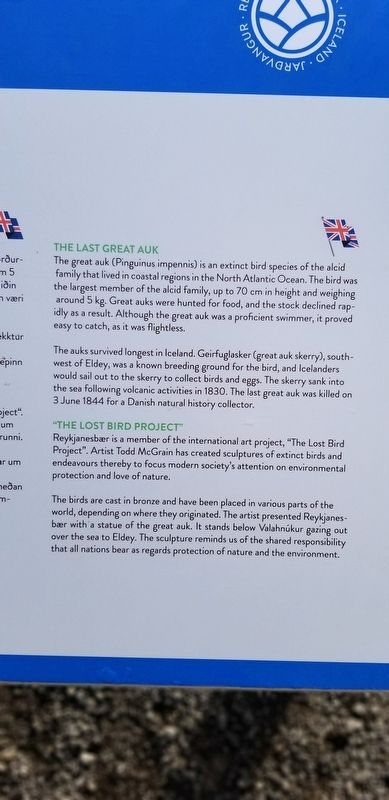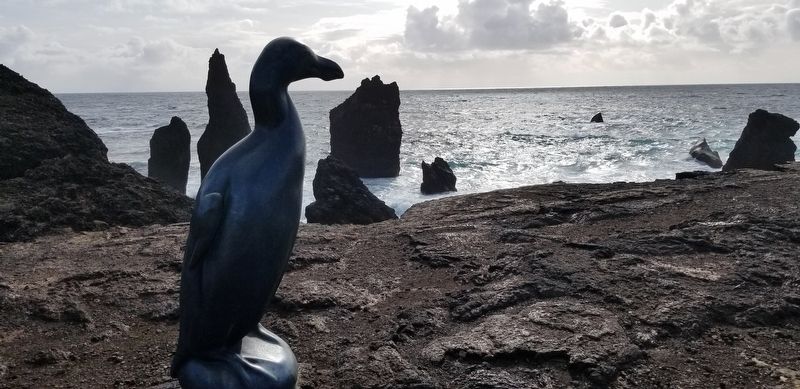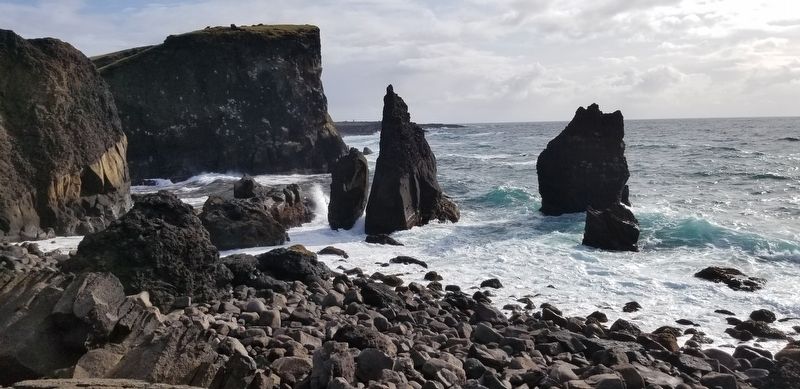Near Hafnir in Reykjanesbęr, Sušurnes, Iceland — North Atlantic and Artic Oceans (a Nordic Island)
The Last Great Auk
The Lost Bird Project
SĶŠASTI MIKLI AUK
Stóraukinn (Pinguinus impennis) er śtdauš fuglategund af alcid fjölskyldunni sem bjó ķ strandsvęšum ķ Noršur-Atlantshafi. Fuglinn var stęrsti mešlimur alcid fjölskyldunnar, allt aš 70 cm į hęš og vegur um 5 kg. Miklir įlfar voru veiddir til matar og stofninn afžakkaši rapp ašgeršalaus fyrir vikiš. Žrįtt fyrir aš stóri aukinn vęri vandvirkur sundmašur reyndist žaš aušvelt aš nį žvķ hann var fluglaus.
Įlfarnir lifšu lengst af į Ķslandi. Geirfuglasker (mikill aukaker), sušur vestur af Eldey, var žekkt ręktunarsvęši fuglsins og Ķslendingar myndu sigla śt į skeriš til aš safna fuglum og eggjum. Kirsuberiš sökk ķ sjóinn eftir eldfjallastarfsemi įriš 1830. Sķšasti stórįlkurinn var drepinn 3. jśnķ 1844 fyrir danskan nįttśrugripasafnara.
"TAPAŠA FUGLAVERKEFNIŠ"
Reykjanesbęr er ašili aš alžjóšlega listaverkefninu, "The Lost Bird Project". Listamašurinn Todd McGrain hefur bśiš til höggmyndir af śtdaušum fuglum og leitast viš aš beina athygli nśtķma samfélags aš umhverfisvernd og įst į nįttśrunni.
Fuglarnir eru steyptir ķ brons og hefur veriš komiš fyrir ķ żmsum heimshlutum, allt eftir žvķ hvar žeir eiga upptök sķn. Listamašurinn afhenti Reykjanesbę styttu af miklum įlfa. Žaš stendur fyrir nešan Valahnśk og horfir yfir sjóinn til Eldeyjar. Skślptśrinn minnir okkur į žį sameiginlegu įbyrgš sem allar žjóšir bera varšandi vernd nįttśru og umhverfis.
THE LAST GREAT AUK
The great auk (Pinguinus impennis) is an extinct bird species of the alcid family that lived in coastal regions in the North Atlantic Ocean. The bird was the largest member of the alcid family, up to 70 cm in height and weighing around 5 kg. Great auks were hunted for food, and the stock declined rapidly as a result. Although the great auk was a proficient swimmer, it proved easy to catch, as it was flightless.
The auks survived longest in Iceland. Geirfuglasker (great auk skerry), south west of Eldey, was a known breeding ground for the bird, and Icelanders would sail out to the skerry to collect birds and eggs. The skerry sank into the sea following volcanic activities in 1830. The last great auk was killed on 3 June 1844 for a Danish natural history collector.
"THE LOST BIRD PROJECT"
Reykjanesbęr is a member of the international art project, "The Lost Bird Project". Artist Todd McGrain has created sculptures of extinct birds and endeavours thereby to focus modern
society's attention on environmental protection and love of nature.
The birds are cast in bronze and have been placed in various parts of the world, depending on where they originated. The artist presented Reykjanes bęr with a statue of the great auk. It stands below Valahnśkur gazing out over the sea to Eldey. The sculpture reminds us of the shared responsibility that all nations bear as regards protection of nature and the environment.
Erected by Jardvangur Reykjanes Geopark Iceland.
Topics. This historical marker is listed in this topic list: Animals. A significant historical date for this entry is June 3, 1844.
Location. 63° 48.743′ N, 22° 42.911′ W. Marker is near Hafnir, Southern Peninsula Region (Sušurnes), in Reykjanesbęr. Marker can be reached from Reykjanesvitavegur, 6.4 kilometers west of Nesvegur (Route 425). The marker is located at the sea cliffs along the ocean and it will be past the Reykjanes Lighthouse on the hill. Touch for map. Marker is in this post office area: Hafnir, Southern Peninsula Region 233, Iceland. Touch for directions.
Other nearby markers. At least 1 other marker is within 18 kilometers of this marker, measured as the crow flies. The Jón Forseti RE 108 Accident (approx. 17.8 kilometers away).
Also see . . . Great auk.
The great auk (Pinguinus impennis) is a species of flightless alcid that became extinct in the mid-19th century. It was the only modern species in the genus Pinguinus. It is not closely related to the birds now known as penguins, which were discovered later and so named by sailors because of their physical resemblance to the great auk. Source: Wikipedia(Submitted on June 10, 2021, by James Hulse of Medina, Texas.)
Credits. This page was last revised on June 10, 2021. It was originally submitted on June 10, 2021, by James Hulse of Medina, Texas. This page has been viewed 157 times since then and 10 times this year. Photos: 1, 2, 3, 4. submitted on June 10, 2021, by James Hulse of Medina, Texas.
Editor’s want-list for this marker. A complete photo of the marker • Can you help?



